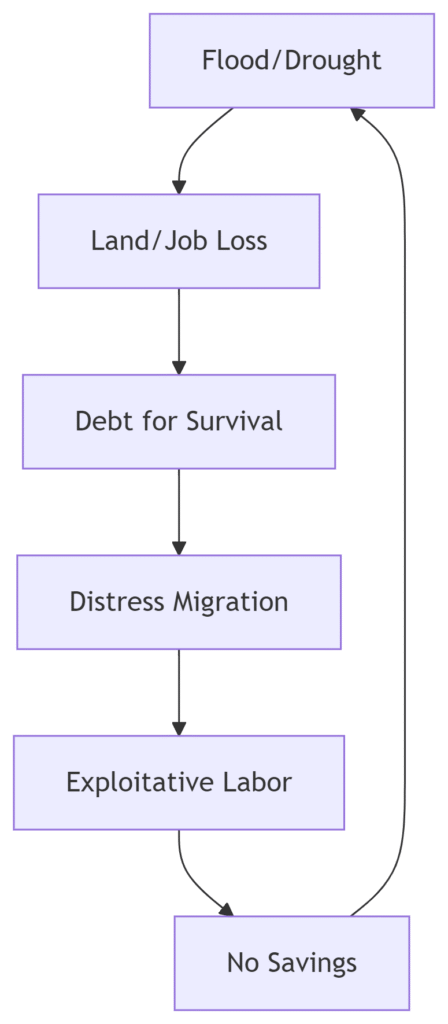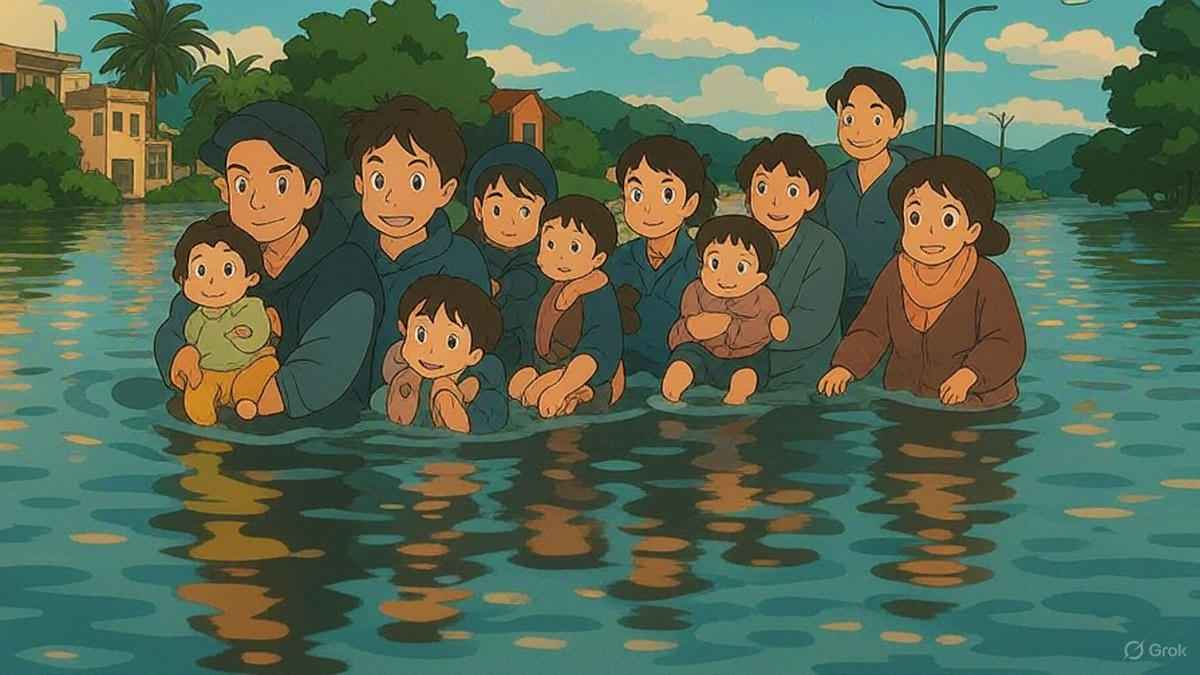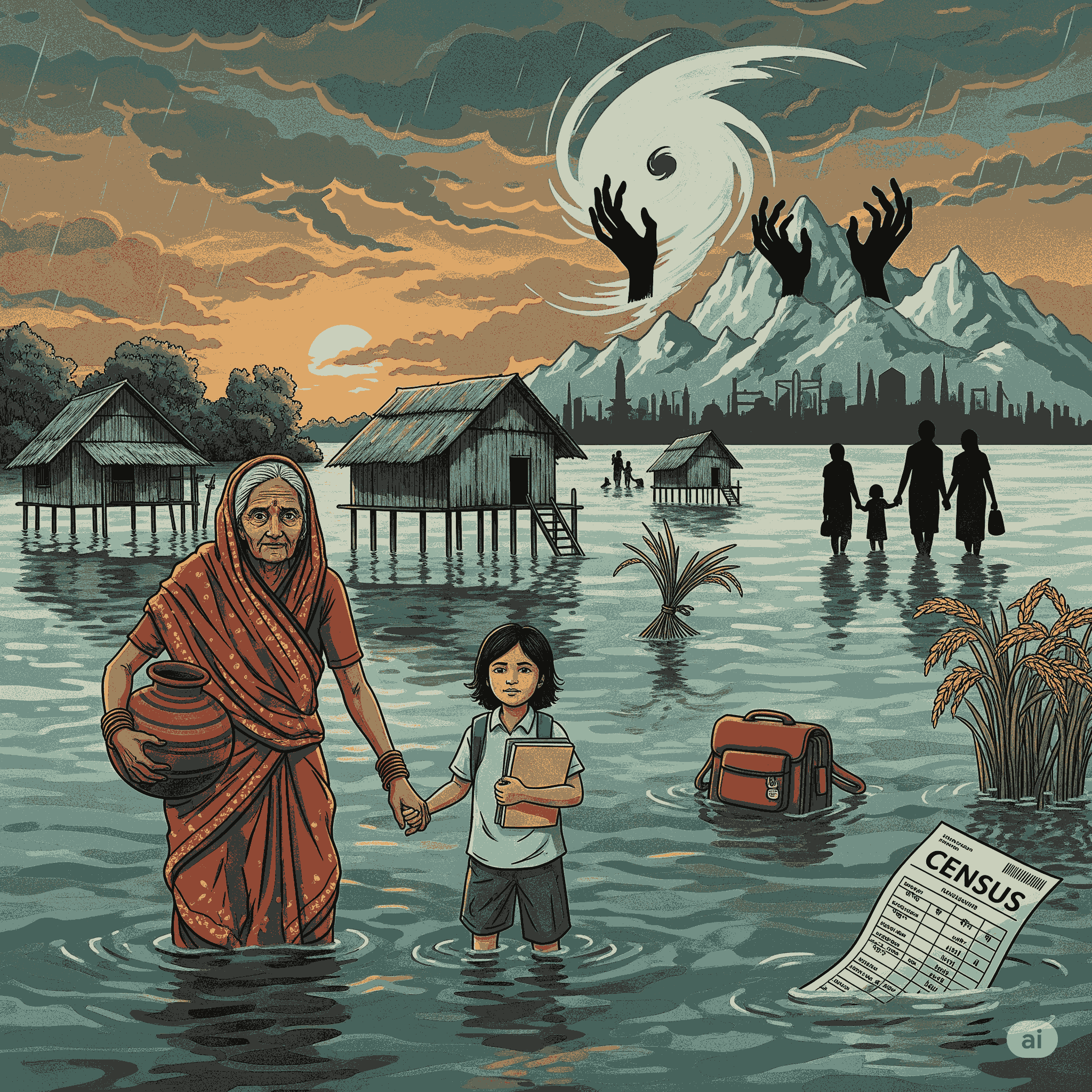India’s Great Climate Migration: When Home Becomes a Battlefield 🌍🔥

Table of Contents
Imagine your entire childhood home vanishing underwater. Picture your family farm turning to dust under a merciless sun.
For millions of Indians, this isn’t science fiction – it’s their terrifying reality. Welcome to India’s climate migration, where floods, droughts, and rising seas are rewriting maps and lives. Let’s dive deep into this unfolding crisis with its technological, social, economic, ecological, political, and psychological tsunami.
🌩️ The Unfolding Disaster: By the Numbers
| Year | Displaced People | Key Trigger States | Climate Finance Spent |
|---|---|---|---|
| 2020 | 3.9 million | West Bengal, Kerala | ₹12,340 crore |
| 2023 | 4.5 million | Assam, Himachal | ₹18,920 crore |
| 2024 | 5.4 million | Assam, Manipur, Maharashtra | ₹21,500 crore (est.) |
Source: Internal Displacement Monitoring Centre (IDMC)
Why this matters:
- By 2050, 45 million Indians could be climate migrants (Climate Action Network South Asia)
- 300 million (25% of India!) live in high-risk coastal/Himalayan zones
- Assam alone saw 2.6 lakh displaced in June 2024 floods – equivalent to emptying 3 Chandigarhs!
⚙️ The 6-Dimensional Impact Matrix
🔌 TECHNOLOGICAL IMPACT
The Paradox: India has satellite monitoring (ISRO) but village-level tech gaps.
- Success: Odisha’s early-warning systems cut cyclone deaths by 90%
- Failure: Tripura’s outdated flood sensors led to 300,000 displacements in 2023
- Digital Divide: Climate migrants in Delhi slums lack Aadhaar-linked relief access
“We get flood alerts on smartphones, but our village has no electricity to charge phones!”
– Fisherman, Sundarbans
👨👩👧👦 SOCIAL IMPACT
The Unraveling Fabric:
- Family Fracture: In Maharashtra’s drought zones, 68% of migrant children live with grandparents
- Gender Crisis: Women constitute 80% of those left behind in flooded villages (SEEDS Report)
- Cultural Genocide: Mising tribe’s stilt-house architecture collapsing in Assam
Shocking Reality: In Odisha’s Satabhaya, relocated families walk 17 km daily to fish in their ancestral sea!
💰 ECONOMIC IMPACT
💸 The $21 Billion Problem: India’s Climate Migration Economic Toll
(Key data from NITI Aayog, World Bank, and SEEDS)
| Economic Layer | Impact | Real-World Example |
|---|---|---|
| Household Level | 74% income drop post-displacement | Assam farmer’s ₹18,000/month → ₹4,500 as Mumbai construction labor |
| State Level | 30% budget diverted to disaster relief | Odisha spends ₹3,200 cr/year rebuilding coasts (equal to 12 new hospitals) |
| National Level | 1.2% GDP loss annually by 2030 | Floods/cyclones cost India ₹6.5 lakh cr in 2018-23 |
- Cost of Displacement: ₹1.2 lakh average income loss per family (NITI Aayog)
- Urban Pressure: Mumbai spends ₹400 crore/year on flood relief for informal settlements
- Agricultural Collapse: 6,000 hectares of Assam’s rice fields became sand deserts in 2024

🌳 ECOLOGICAL IMPACT
Domino Effect:
- Himalayan landslides → Silt choking the Brahmaputra → Deadlier floods
- Mangrove deforestation (Sundarbans) → Reduced storm buffers → Faster erosion
- Groundwater pumping in drought zones → Land sinking in Punjab at 3 cm/year
Tipping Point: Sundarbans lost 12% of land area since 1969 – equivalent to 45,000 football fields!
🏛️ POLITICAL IMPACT
The Governance Crisis:
| Agency | Responsibility | Climate Migration Role |
|---|---|---|
| NDMA | Disaster Management | Only tracks disasters, not migrants |
| Environment Ministry | Climate Policy | No rehabilitation mandate |
| Labour Ministry | Migration | Only tracks economic migrants |
Fatal Gap: The 2024 Disaster Management Act amendments ignored climate migration protocols despite parliamentary recommendations.
😔 PSYCHOLOGICAL IMPACT
The Invisible Wounds:
- Solastalgia: The grief of losing your home while still living there (common in Odisha coastal villages)
- Child Trauma: 55% of Assam’s flood-displaced children show PTSD symptoms (UNICEF Survey)
- Hope Erosion: Sundarbans farmers report “permanent despair” after 3rd cyclone rebuild

📍 Ground Zero: 5 Crisis Hotspots
1️⃣ ASSAM’S FLOOD GRAVEYARD
- Problem: Brahmaputra now floods 5x/year vs. 2x in 1990s
- Human Cost: The Mising tribe’s stilt houses have been underwater for months
- Irony: World Bank funded ₹2,000 cr embankments that collapsed in 2023
2️⃣ SUNDARBANS: THE SINKING KINGDOM
- Stats: 4 islands fully submerged since 2000, displacing 15,000
- Survival Strategy: Men migrate to Kerala construction sites, and women become domestic help in Kolkata
- Psychological Toll: 73% report anxiety about “returning to drowned villages”
3️⃣ HIMACHAL’S MELTING MOUNTAINS
- Shocking Change: 450 cloudbursts in 2023 vs. 32 in 2010
- Economic Impact: Apple belt farmers lost 40% income in 5 years
- Tech Failure: Landslide sensors cover only 12% of high-risk zones
4️⃣ MARATHWADA’S DEATH BY THIRST
- Drought Cycle: 5 failed monsoons in 7 years
- Social Collapse: 80% of the Beed district’s men migrate seasonally
- Child Impact: School dropout rate up 300% since 2018
5️⃣ KERALA’S PERPETUAL DELUGE
- New Normal: Floods every year since 2018
- Innovation Fail: Tech-savvy state but no climate migration database
- Cultural Loss: 120 traditional “Nalukettu” homes abandoned in 2023
💡 The Way Forward: A 7-Point Survival Blueprint
- TECH UPGRADE
- AI flood prediction tools in all 225 high-risk districts
- Blockchain-based relief tracking to prevent fund leaks
- ECONOMIC SHIELD
- Climate Risk Insurance for farmers (pilot in 50 districts)
- Green jobs in safe zones: Solar parks in the Rajasthan drought belt
- PSYCHOLOGICAL ARMOR
- Trauma counseling in relocation camps
- “Memory museums” for displaced communities
- POLICY REVOLUTION
- National Climate Migration Code (draft bill pending since 2022)
- Census 2026 to include “climate displacement” category
- ECOLOGICAL DEFENSE
- Mangrove belts along all 7,500km coastline
- Landslide-resistant native tree walls in the Himalayas
- SOCIAL SAFETY NET
- Migrant child education guarantee
- Women-run climate-resilient farms
- GLOBAL ACTION
- Demand loss/damage fund access for vulnerable states
- South-South knowledge exchange with Bangladesh’s climate shelters
“We don’t want pity. We want policy.”
– Climate migrant from Odisha’s vanished Satabhaya village
❓ Deep-Dive FAQs- india’s climate migration
Q: Why can’t people just rebuild after floods?
A: Assam farmers show flood silt takes 3 years to make land farmable, but floods now come yearly. The math doesn’t work.
Q: How does this affect India’s census?
A: Migrants settling illegally in cities become “invisible citizens” – uncounted, unplanned slums strain resources.
Q: Do climate migrants get refugee status?
A: No! The UN Refugee Convention excludes them. India has no domestic law. Result: zero legal protection.
Q: What’s the psychological toll on children?
A: Assam studies show displaced children have:
- 4x higher school dropout rates
- 3x more malnutrition cases
- 68% report “constant fear of rain”
Q: Can technology solve this?
A: Only partially. Kerala has great disaster apps but no policy for displaced families’ livelihoods. Tech without policy = bandage on bullet wound.
🌈 Reasons for Hope – india’s climate migration
- Odisha’s Miracle: From 10,000 deaths in the 1999 super cyclone to zero casualties in 2023 Cyclone Mocha
- Assam’s Stilt-Schools: Flood-proof bamboo schools keep education flowing
- Tamil Nadu’s AI Farmer: Chatbots deliver real-time crop advice to drought-hit farmers
- Youth Innovation: Kerala teens developed low-cost landslide sensors from e-waste
The Bottom Line: Climate migration isn’t about “moving” – it’s about justice. As Ranjan Panda (“Water Man of Odisha”) says: “When the state protects a ₹10,000 crore coastal highway but not fishing villages, we must question our priorities.”
What YOU Can Do:
✅ Demand that climate migrants be counted in the Census 2026
✅ Support on-ground heroes like SEEDS and Water Man of Odisha
✅ Reduce your water footprint – India has just 4% of the global water for a 17% population
Sources: IDMC Global Report 2024, NITI Aayog Climate Assessment, Down To Earth Disaster Tracker
The final question isn’t “Will more Indians become climate migrants?”
It’s “Will we finally SEE them?” 👀💔

